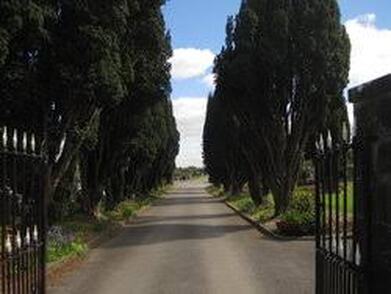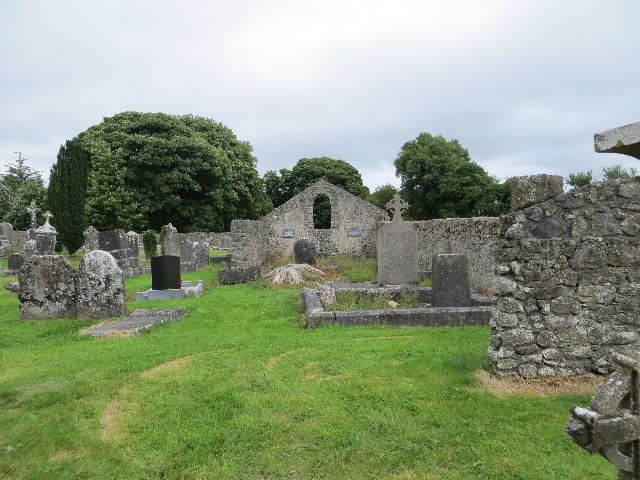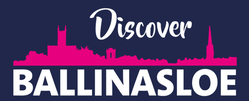by Barry Lally“Only the dead exist fully. The lives of the living are fragmentary, doubtful and subject to change; but the lives of the dead are complete, free from the sway of time, the all-but omnipotent lord of the world.” Bertrand Russell With the approach of the longer nights our thoughts seem naturally to gravitate towards those who have gone before us into “that undiscovered country from whose bourn no traveller returns”. Ballinasloe’s Creagh Cemetery is an intriguing place where the dead probably far outnumber the living citizens of the town. It reflects, moreover, much of our local history. According to John the Evangelist, Jesus said: “In my Father’s house are many mansions”. The same is true of Creagh. Today I propose to visit all five “mansions” and should esteem it an honour were you to favour me with your company. Very good. Then let us proceed. As we make our way through the main gate we find ourselves in an avenue flanked by yew trees, an evergreen species invariably found in cemeteries, chosen because of its famed longevity as a symbol of the Christian belief in everlasting life. Besides, its poisonous foliage would have deterred farmers from allowing their livestock to trespass. A first right takes us from the main avenue into the Church of Ireland and Presbyterian burying ground. Creagh Cemetery largely occupies a slope that rises towards the south. This Protestant section is on a steeper gradient and overlooks the Catholic graveyard across the avenue. Both were laid out in the 1880s, but here the graves are sparser, bearing witness to the decline of a community whose members once dominated the commercial and professional life of the area. During the early1920s fifty per cent of the local Protestant population re-located to Britain and Northern Ireland, establishing a pattern of contraction that has continued ever since. Notables interred here include Rev. Dr. James Whigham, one of the town’s earliest Presbyterian ministers, who gave his name to the Whigham Hall at the rear of the church in Society Street, used for “hops” in the 1950s, as well as Musical Society rehearsals; Dr. William Rutherford, a popular medical man whose monument stands near the Brackernagh end of the Harris (Burma) Road; and Henry J. McClenaghan, proprietor of “The Western Star” newspaper. Notice the three obelisks over on the left, a monumental style not found elsewhere in Creagh. We mount a step or two to bring us into the medieval graveyard shared by both Catholics and Protestants. Without disrespect to those reposing here, we can say that the scene confronting us would surely be dear to the heart of the maker of a horror film: scattered at random over the uneven ground, lichen-covered, rounded and shouldered tombstones lean drunkenly under the shadow of a ruined church. In the early 1970s it was rumoured to be the venue of nocturnal Satanic rites comprising, amongst other things, naked cavorting around a grave. Eighteen-century headstones abound, the most elaborate being the Staunton monument featuring the instruments of the Passion of Christ, now sadly overgrown with ivy. Members of the Trench family, later Earls of Clancarty, are buried here, including Power Le Poer Trench (1770 – 1839), Archbishop of Tuam. A railed tomb encloses the remains of the Reeves family of Reeves’s Lane (now Davitt’s Place) off Dunlo Street. Here, too, are the graves of Primitive Methodists, notably that of John Queale, a tanner. The Church of Ireland was no longer used for worship from 1793 when the predecessor of St. John’s was built on Knockadoon (now Church Hill). It served as a chapel of ease up to 1825 and has been in ruins since 1870. Retracing our steps, we cross into the Catholic cemetery, which presents an aspect in sharp contrast to the medieval one we have just left. Here the funerary monuments stand bolt upright in straight rows like soldiers on parade. Over to the left, just inside the main gate, we see Creagh’s most imposing Celtic cross marking the resting place of Matt Harris MP (1826 – 1890). Born in Roscommon Town, he spent most of his life as a building contractor in Ballinasloe. Though a major influence on the formation of the Irish Land League, at heart he was probably more a separatist than an agrarian reformer. In this general area we find also the grave of Eugene Watters (1919 – 1982), widely regarded as the most versatile creative writer in Irish to come from a non-Gealtacht background. His achievements await a fitting memorial in his native town. Down near the north-west corner a monument was erected in 1948 at the grave of a man described on the stone as the King of the Travellers. It has since disappeared, possibly removed by a rival claimant to the throne. Next we visit the north graveyard used for Catholic burials since 1792. In appearance it is much like the medieval burying ground, though somehow the atmosphere strikes one as less sinister. Here we have the ruins of a Penal chapel dating from 1702, as well as the vestigial remains of a larger chapel from 1824. A Brabazon altar stone once stood inside the latter building and had originally been part of the Penal chapel. Its inscription read: “Pray for Mr. Anthony and Mrs. Catherine Brabazon who caused this altar to be erected April 2nd 1756”. For some reason it was removed from the cemetery and could be seen resting against the north wall of the 1933 Creagh Church up to at least the mid-1950s. Its present whereabouts are unknown. Buried here is Thomas Costello (1787 – 1831), Bishop of Clonfert, as well as Archdeacon Laurence Dillon who died in 1854 and had initiated the building of St. Michael’s Church. Amongst the laity reposing here are soldiers of various British Army regiments quartered up to around the time of the Crimean War (1854 – 1856) at a barracks on the site of the old Convent of Mercy National Schools in Society Street.
East of here we enter an area through a small iron gate in the wall. It resembles nothing so much as a meadow, though in fact it contains the bodies of some 800 Mental Hospital patients unclaimed by their relatives and buried here up to the 1960s. Those boulders and the cross that we see are recent additions. It is probably the most depressing section of Creagh Cemetery and a sad reflection on the attitude to psychiatric illness that was once prevalent. And so our visit ends as we make our way back towards the main gate. See how the rain has graciously held off thus far, and with a modicum of luck we may reach our homes dry-headed.
14 Comments
Paul J. Brady
20/1/2021 06:36:53 pm
The picture is not identified. Is it the 1702 church or 1824 church?
Reply
Damian Mac Con Uladh
2/2/2021 08:24:42 am
It's the 1824 church.
Reply
Paul Flynn
17/5/2021 10:36:49 am
Thanks Peter, this has been really helpful. Have spent years trying to find the graves of two relatives who died around 1910.
Reply
Paul Flynn
17/5/2021 07:16:15 pm
Apologies Barry!
Reply
Jean Brennan
10/8/2021 03:37:39 pm
Hi Paul ,I was searching for two graves in that cemetery for many years .I got in touch with the freedom of information in Galway.I visited those graves last week. Hope that helps
Reply
David Duane
21/2/2023 02:31:15 pm
Hi Jean,
Paul
12/9/2023 09:22:20 pm
Hi, just seen your response. The years would be around 1910, were the two graves you were looking for from that era or more recent. I've never heard of using FOI before
Damian Mac Con Uladh
12/9/2023 09:27:15 pm
There is a register available in the council offices in Ballinasloe and it's also online. I can check if you give me the names.
Reply
Paul
12/9/2023 09:36:45 pm
Hi, that would be really appreciated, many thanks for that. They are James Harrison (died April 1910) and his daughter who died between 1907 and 1916. Her name was Kathleen Harrison. They may have been buried in Kilclooney but I can't see. James had served in British army so I'm not sure if there was a soldier's plot. T
Damian Mac Con Uladh
25/9/2023 07:43:48 am
Hi Paul
Andrew Newman
3/6/2021 09:26:17 am
A great insight into the cemetery. My grandparents and uncles are buried there. They lived in an are known locally as "Stauntons Corner" Creagh, right across the road. Next time I visit the place I will be referring to your piece. Thank you and well done.
Reply
Damian Mac Con Uladh
21/2/2023 02:58:48 pm
In Reply to David Duane
Reply
1/8/2023 07:29:57 pm
I am searching for colahan graves in the Creagh cemetary. Any help would be greatly appreciated
Reply
Damian Mac Con Uladh
12/9/2023 09:28:16 pm
What names are you looking for exactly? I can check in the the register.
Reply
Leave a Reply. |
CLICK HERE to read the Latest Ballinasloe News Articles
June 2024
|
The Town Team was set up by BACD Ltd. to revive the fortunes of Ballinasloe and its hinterland. With the main focus to build on the town’s many strengths, change existing negative perceptions and bring about measurable improvements in the town centre economy and its wider social value.
|
Ballinasloe Area Community Development Ltd.
Ballinasloe Enterprise Centre Creagh Ballinasloe Co. Galway |
All generic photos and images have been sourced and are free of copyright or are clip art images free of copyright. Photos of Ballinasloe have been donated by BEC. If you have any photos that you would like included on the website please email us
Copyright © All rights reserved, 2024 BACD



 RSS Feed
RSS Feed
